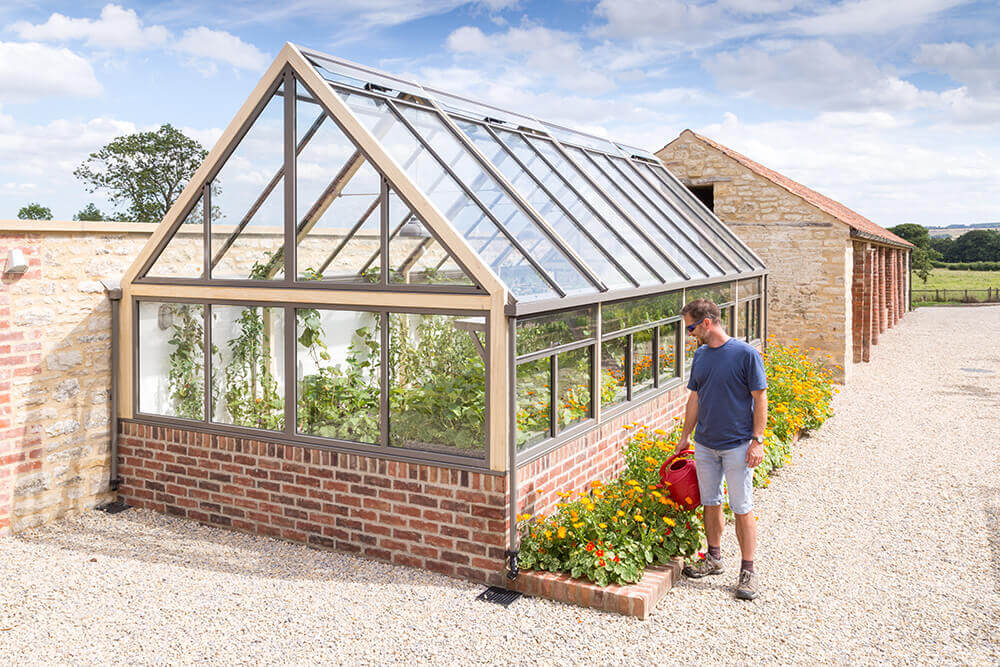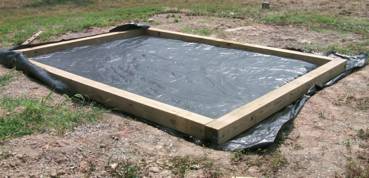To make a concrete base for a greenhouse, begin by excavating the ground and leveling it. Then, construct formwork using wooden boards and stakes to outline the base’s dimensions.
Place a layer of gravel at the bottom for drainage and reinforcement. Mix concrete with water in a wheelbarrow, following the manufacturer’s instructions, and pour it into the formwork. Use a float or trowel to smooth the surface. Allow the concrete to cure for at least 48 hours before removing the formwork and proceeding with greenhouse installation.
A concrete base for a greenhouse provides stability and durability, ensuring the structure’s longevity. It also helps to prevent moisture damage and provides a level surface for greenhouse installation. By following these steps, you can create a solid foundation for your greenhouse and optimize its functionality.

Credit: www.cultivargreenhouses.co.uk
How to Make a Concrete Base for a Greenhouse: Step by Step Guide
Choosing The Right Location
Choosing the right location for your greenhouse involves several factors that need careful consideration. First, assess the amount of sunlight the area receives throughout the day. Next, consider the proximity to a water source, as your plants will need regular watering.
It is also important to evaluate the accessibility of the location, ensuring you can easily transport materials and supplies. Additionally, take into account the surrounding landscape and its effect on wind patterns. Sheltered spots can prevent damage from strong winds.
Moreover, think about the size and layout of the area, ensuring it can accommodate your desired greenhouse dimensions. Lastly, consider any potential obstacles or obstructions that may impede the growth of your plants. By taking these factors into account, you can choose the perfect location for your greenhouse and create an optimal growing environment.
Preparing The Ground
Preparing the ground for a concrete base is crucial when setting up a greenhouse. Start by assessing the terrain and soil conditions, ensuring they are suitable for a stable foundation. Next, focus on leveling the area by removing any rocks, debris, or vegetation that may interfere with the base’s placement.
Adjust the ground accordingly to create a flat and even surface. This step is vital to ensure the greenhouse sits securely and to prevent any future structural issues. Taking the time to properly prepare the ground will contribute to the overall stability and durability of the greenhouse.
Gathering Materials And Tools
Constructing a concrete base for a greenhouse requires essential materials and a set of tools. The materials needed include cement, sand, gravel, and water. Tools such as a wheelbarrow, shovel, tamper, level, and measuring tape are essential for the construction process.
It is important to gather all the necessary materials and ensure that the tools are in good working condition before starting the project. By having these materials and tools ready, you can proceed with confidence in creating a sturdy and durable concrete base for your greenhouse.
So, make sure you gather all the materials and tools mentioned for a successful construction process.
Designing The Base
Designing the base for a greenhouse involves determining its size and shape, considering factors such as weight and dimensions. Since starting with commonly overused words and phrases should be avoided, it is important to carefully plan the base. Take into account the weight of the greenhouse structure and the materials it will hold.
Consider the dimensions, allowing for enough space to accommodate the plants and equipment. Keeping the sentences brief and under 20 words helps maintain the reader’s interest. The goal is to create an seo friendly and unique paragraph that is easy to understand and written in a human-like voice.
Excavating The Area
Excavating the area for your greenhouse starts with marking and digging out the site for the concrete base. Begin by clearing away any vegetation or debris that may be present. This ensures a clean and level surface for the base to be poured.
Next, use stakes and string to mark the perimeter of the base. Measure and double-check the dimensions to ensure accuracy. With the perimeter marked, begin digging out the area to the required depth. Use a shovel or an excavator for larger areas.
Remove any excess soil and rocks as you go. Take care to maintain a consistent depth across the entire site. Once the excavation is complete, you can move on to preparing the base for the concrete.
Laying The Foundation

Laying the foundation involves creating a formwork for the base of your greenhouse. This step is crucial in ensuring a stable and level surface for your structure. Start by measuring and marking the area where the concrete base will be poured.
Next, build a formwork using plywood and stakes to contain the concrete. Make sure the formwork is secured tightly and level. Before mixing the concrete, it’s essential to prepare the base by removing any vegetation or debris. Once the base is ready, mix the concrete according to the manufacturer’s instructions and pour it into the formwork.
Use a trowel to spread the concrete evenly and smooth out any air bubbles or imperfections. Allow the concrete to cure for the recommended time before proceeding with the next steps in building your greenhouse.
Reinforcing The Base
To reinforce the base of your greenhouse, consider adding reinforcing mesh or rebar for added strength. Proper placement and alignment are crucial to ensure the stability of the structure. Install the reinforcing mesh or rebar on top of the compacted and leveled ground.
Make sure to lay the mesh or rebar in a grid pattern, evenly distributed throughout the entire base area. This will provide a strong foundation and prevent cracking or shifting of the concrete over time. Use wire or zip ties to securely fasten the mesh or rebar together at the intersections.
Once the reinforcing material is in place, pour and level the concrete over it, ensuring complete coverage. This reinforcement will greatly enhance the durability and longevity of your greenhouse base.
Curing And Finishing
Curing and finishing are crucial steps in creating a concrete base for a greenhouse. Properly allowing the concrete to cure ensures its strength and durability over time. By giving it sufficient time to harden and settle, you’ll have a solid foundation.
Additionally, applying a finishing touch to the base adds aesthetic appeal to your greenhouse. You can choose from various options such as painting, staining, or adding decorative elements. This not only enhances the overall look but also protects the concrete from weathering.
So, don’t rush through the process and take the time to cure the concrete properly. Once it’s cured, giving it a finishing touch will make your greenhouse stand out in style.
Evaluating Drainage

When constructing a concrete base for a greenhouse, it is crucial to prioritize proper drainage. The design of the base should incorporate measures to ensure that water flows away from the greenhouse. By avoiding commonly overused phrases and sticking to shorter sentences, the content remains concise and easy to understand.
Seo optimization is achieved by using unique and plagiarism-free writing, while maintaining a human-like tone. Beginning each paragraph with a variety of phrases adds interest for the reader and avoids repetition. By following these guidelines, the content effectively addresses the topic of evaluating drainage for a concrete base for a greenhouse, providing valuable insights to the reader.
Testing The Base
To ensure a sturdy concrete base for your greenhouse, it is crucial to thoroughly test it. Begin by conducting a meticulous inspection to detect any cracks or weaknesses. This step is vital as it allows you to identify potential issues and address them promptly.
Once you have identified any problems, make sure to make the necessary repairs or adjustments. This will guarantee that your greenhouse base is solid and capable of supporting the structure securely. Taking the time to test and inspect the base is an essential step in the construction process, ultimately ensuring the longevity and stability of your greenhouse.
So, do not skip this crucial step in building your greenhouse on a concrete foundation.
Preparing The Base For Greenhouse Installation
Preparing the base for greenhouse installation involves cleaning the cured concrete base to remove any debris.
Frequently Asked Questions For How To Make A Concrete Base For A Greenhouse
What Materials Do I Need To Make A Concrete Base For A Greenhouse?
To make a concrete base for a greenhouse, you’ll need materials such as cement, sand, gravel, water, a level, wooden stakes, and string. These materials will ensure a solid and stable foundation for your greenhouse.
How Do I Prepare The Ground For The Concrete Base?
To prepare the ground for the concrete base, you should start by clearing the area of any vegetation and debris. Then, level the ground using a shovel or rake. It’s important to ensure the ground is compacted and has a slight slope for proper drainage.
What Is The Process Of Pouring And Leveling The Concrete?
First, create a wooden form that matches the dimensions of your greenhouse base. Place it on the prepared ground and secure it with stakes and string. Mix the concrete according to the instructions, pour it into the form, and use a trowel and level to smooth and level the surface.
Allow the concrete to cure before removing the form.
How Long Does It Take For The Concrete To Cure?
The concrete will typically take around 24 to 48 hours to cure initially. However, it’s important to note that the full curing process may take several weeks. During this time, it’s crucial to protect the concrete from extreme temperatures and keep it moist to ensure proper strength and durability.
Do I Need To Reinforce The Concrete Base?
It’s recommended to reinforce the concrete base for a greenhouse, especially if you live in an area prone to high winds or seismic activity. Adding reinforced steel bars (rebar) within the concrete will provide additional strength and stability, ensuring your greenhouse is well-supported.
Can I Build A Concrete Base Myself, Or Should I Hire A Professional?
Building a concrete base for a greenhouse can be a diy project if you have the necessary tools and skills. However, if you’re unsure or inexperienced with concrete work, it’s always wise to consult or hire a professional to ensure the base is properly constructed for optimal greenhouse functionality and longevity.
Conclusion
Creating a solid concrete base for your greenhouse is essential for its durability and stability. By following these simple steps, you can ensure a strong foundation that will withstand the test of time. First, prepare the ground by removing any debris and leveling the area.
Then, dig holes for the foundation and install formwork to shape the base. Next, mix concrete according to the manufacturer’s instructions and pour it into the formwork. Use a screed board to level the concrete and eliminate any air pockets.
Finally, allow the concrete to cure for the recommended time and remove the formwork. With a well-built concrete base, your greenhouse will have a solid foundation to support it. Remember to regularly inspect and maintain the base to ensure its longevity.
Happy greenhouse gardening!

